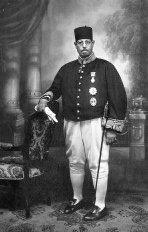Khan Bahadur Sir Mohammad Usman | |
|---|---|
 Governor of Madras Presidency 1934 official picture | |
| Member of the Executive Council of the Viceroy of India | |
| In office 1942–1947 | |
| Monarch | George VI of the United Kingdom |
| Governors‑General | Victor Hope, 2nd Marquess of Linlithgow Archibald Wavell, 1st Earl Wavell |
| Succeeded by | None |
| Member of the Defence Council of India | |
| In office 1940–1941 | |
| Monarch | George VI |
| Governor of Madras Presidency (Acting) | |
| In office 16 April 1934 – 16 August 1934 | |
| Premier | Raja of Bobbili |
| Preceded by | George Frederick Stanley |
| Succeeded by | George Frederick Stanley |
| Minister of Home (Madras Presidency) | |
| In office 1932–1934 | |
| Premier | Raja of Bobbili |
| Governor | George Frederick Stanley |
| Member of the Executive Council of the Governor of Madras | |
| In office 1925–1930 | |
| Premier | Raja of Panagal P. Subbarayan |
| Governor | George Goschen, 2nd Viscount Goschen Sir Norman Majoribanks George Frederick Stanley |
| Succeeded by | None |
| Personal details | |
| Born | 1884 Tanjore, British India |
| Died | 1 February 1960 (aged 75–76) Madras, India |
| Alma mater | Madras Christian College |
| Occupation | Lawyer, hakim |
| Profession | Politician |

Khan Bahadur Sir Mohammad Usman KCSI KCIE (1884 – 1 February 1960) was an Indian politician, hakim and socialite who served as the Minister of Home for the Madras Presidency in the Justice Party government of the Raja of Bobbili and as the first Indian acting Governor of Madras from 16 May 1934 to 16 August 1934. His name is often written Muhammad Usman.
Usman was born into an aristocratic family of Tanjore in the Madras Presidency in 1884. He graduated from Madras Christian College and joined the Justice Party. He was elected to the Madras Legislative Council and later, to the Governor's executive council. Usman served as the member of posts and air in the Viceroy's Executive Council between 1942 and 1947. He died in 1960 at the age of 76. He was a part-time hakim or doctor in Unani medicine and used his influential position in the provincial administration to promote indigenous systems of medicine.
In person, Usman was both tall and very heavy. He was once described by V. S. Srinivasa Sastri as having a "magnificent frame", and Sastri's biographer says he was "of gargantuan size".[1]
- ^ Jagadisan, T. N., V. S. Srinivasa Sastri (Publications Division, Ministry of Information and Broadcasting, Govt. of India, 1969), p. 171